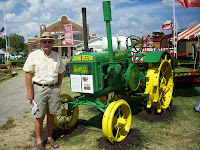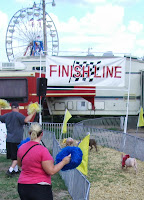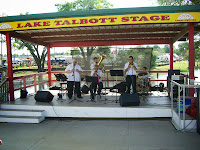| Forestry, Fish & Game in Eisenhower Bldg |
I previously shared Isaac Werner's affection for wild birds. (Isaac & his "Pet" Game Birds, 8-8-2013) Early settlers failed to recognize the need for conservation of game birds, and although laws were passed to protect against unlimited hunting of game and song birds in the late 1800s, it was too late for some. I'm sure that if Isaac could have joined me for a stroll around the fairgrounds, he would have enjoyed the display in the Eisenhower Building pictured at left.
However, this blog is not really about Isaac. In about 1940, my father went to work at the Forestry, Fish & Game headquarters near Pratt, Kansas. At that time, most people called it The Fish Hatchery, and many people still do. My parents had married in 1934, and when they moved to Pratt about 1940 for my father's new job, my older brother was about three years old.
 |
| Early photograph of the Fish Hatchery |
Soon, they were able to move into one of the cottages on the Hatchery grounds, and it was a happy time for them, with other young couples living there. When the men were at work, the wives finished their household chores and gathered for coffee breaks and card games, while their children played together.
One of my father's responsibilities was driving a fish display truck to fairs and other public events. The back of the truck was outfitted with tanks displaying fish found in Kansas rivers and lakes. Naturally, when I saw the mobile fish tanks on display at the state fair I thought of my father and one particular trip he made with the fish display truck.
 |
| Mobile fish display at KS state fair |
In over forty years of marriage, my parents spent only four nights apart (excluding a couple of short hospital stays), but as the employee who drove the fish display truck, my father was required to travel to a destination where he remained overnight. Apparently, my mother had raised quite a fuss about being left at home.
Here's the romantic part of my story--At the end of a long day watching over the fish display and answering visitors' question, my father returned to his hotel room, exhausted. Those were the days of overnight delivery of letters, and he knew he had better write a letter to my mother or he would be in even worse trouble when he got home. He had brought no stationery, and there was no complimentary writing paper in the hotel room. All that he could find was a can of Dutch Maid scouring powder under the bathroom sink. Carefully, he tore along the overlapping edges of the Dutch Maid label, and as he had hoped, the back of label was white. He took out his pencil and wrote my mother a love letter, explaining how sorry he was that she couldn't come with him, telling her how much he missed and loved her, and asking "Corky" to take good care of his mother. I don't know how he managed to find an envelope and get the letter mailed to my mother. What I do know is that when Mother went to the nursing home over sixty years later, I found that love letter in the top drawer of my mother's bureau.





















